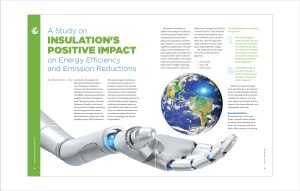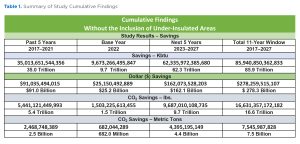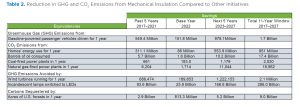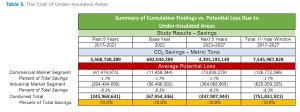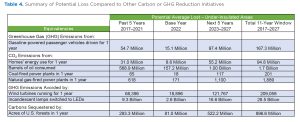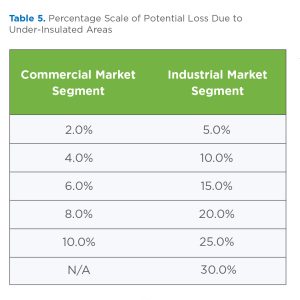A Study on Insulation’s Positive Impact on Energy Efficiency and Emission Reductions
In 2023, the Foundation for Mechanical Insulation Education, Training, and Industry Advancement (Foundation) and the National Insulation Association (NIA) commissioned Industry Insights to perform an independent, third-party survey of manufacturers of ready-to-use insulation products for higher operating service temperatures to assess the amount of energy saved and the reduction in carbon and other greenhouse gas (GHG) emissions. This study sought to determine the value and role mechanical insulation systems have in assisting industries in the United States and Canada to achieve and maintain their respective decarbonization goals. A secondary goal was to educate facility owners, engineering firms, government agencies, code officials, and others as to the value of mechanical insulation as an energy-saving and decarbonization technology that should be prioritized.
Mechanical insulation is defined to encompass all thermal, acoustical, and personnel safety requirements for mechanical piping and equipment, and heating, ventilation, and air conditioning (HVAC) applications. The operating or service temperatures for those applications can range from cryogenic levels -423°F (-253°C) to above 1,000°F (538°C). This study’s scope examined mechanical insulation used at “higher operating service temperature,” which was defined to be between 150°F (66°C) and 800°F (427°C). This study did not include some materials that were suitable for all or a portion of the 150 – 800°F temperature range and did not include other operating temperature ranges.
The study covers a time span of 11 years, broken into three segments:
- 2017 to 2021,
- 2022, and
- 2023 to 2027
- How much energy is saved, and GHG emissions reduced, over time by the use of mechanical insulation systems in the higher operating service temperatures in the commercial/building and industrial market segments?
- Conversely, how much is at risk or lost due to under-insulated areas in the higher temperature market segments?
Decarbonization
Decarbonization is the term used to describe efforts to keep our planet from warming more than 1.5°C above pre-industrial levels. Most countries, including the United States and Canada, have goals to reach net zero emissions by 2050, meaning that all GHG emissions produced are counterbalanced by an equal number of emissions that are eliminated.
There are two basic aspects to decarbonization. The first entails reducing the GHG emissions produced by the combustion of fossil fuels, and the second is energy efficiency—to reduce the demand for energy.
As decarbonization strategies are developed and implemented, energy efficiency is more important than ever. The impact all insulation industry segments can contribute to that effort should not be overlooked or underappreciated. This study confirms the significant contribution the mechanical insulation market segment in particular can make to energy efficiency and, accordingly, carbon reduction initiatives.
If all insulation systems deliver energy savings and emission reduction benefits, why should mechanical insulation be viewed differently? The answer is related to temperature differential and heat loss/gain. The greater the temperature differential between ambient and service/operating temperature, the greater the opportunity for energy savings and reduction in carbon emissions. Accordingly, mechanical insulation applications, on a unit basis compared to other insulation segments, will yield much greater savings.
Renewable energy sources and electrification will not by themselves bring us to net zero emissions. Mechanical insulation can and should play a substantial role alongside the transition to renewable energy and electrification.
The study points out the obvious and impressive savings, but more importantly, it highlights what could be saved if mechanical insulation systems were viewed as a decarbonization technology that is proven and available now.
When you consider the potential of complete and intact mechanical insulations systems, the total energy savings and emission reduction findings are impressive, and the potential loss of even a portion of those savings should not be overlooked. The study findings, summarized in Table 1, are conservative and do not include possible loss of benefits from partial or under-insulated areas. “Under insulated” is defined as items left uninsulated that could have been insulated, or where insulation has been removed and not replaced; items that are either not code compliant or are compliant but do not follow the most current model energy or building codes; items that are not specification compliant; and/or items that are damaged. More information is provided in the body of the report.
The United States represents 91% +/- of the findings, and the Canadian portion equates to 9% +/-.
It is important to note the study results are cumulative beginning in 2017 and ending in 2027. “Cumulative,” for the purposes of the study, means successive inclusion from year to year, so what exists in one year will exist in the next, and every year thereafter, unless something happens that changes the basis of the information.
For example, if a mechanical insulation system saves 1 metric ton of carbon emissions in 2021, it is assumed that it will save the same amount in 2022, 2023, and each year thereafter. Similarly, if 2% of the insulation system is under insulated in 2021, 2% will be considered to be under insulated in 2022 and each year thereafter.
How do these results compare to other carbon reduction initiatives or GHG reduction equivalents? We turned to the U.S. Environmental Protection Agency Greenhouse Gas Equivalencies Calculator to answer that question.1 Results appear in Table 2.
Defining “Under Insulated”
For purposes of the study, “under insulated” was defined as including the following:
- Items left uninsulated that could have been insulated (unions, flanges, valves, etc.)
- Items that are not code compliant
- Items that are code compliant but do not follow the most current model energy or building codes
- Items that are not specification compliant
- Items that are damaged by/as a result of:
o Other crafts working on site
o Weather-related events (wind, hail, flooding, etc.)
o Moisture intrusion or intrusion of other contaminants (product, oil, grease, etc.)
o Mechanical equipment (forklifts, scaffolding, ladders, etc.)
o Maintenance and/or other facility personnel
o Environmental elements (corrosive or contaminant environment)
o Being used as a walking surface or work platform (pipe rack, for example)
o System penetration for inspection purposes (destructive testing) and not being repaired in a proper and/or timely manner
o Washdown or similar occurrences
o Fire or similar events - Installation quality issues
- Insulation removed for maintenance and/or other purposes and not replaced
- Insulation removal for maintenance and/or other purposes exposing the remaining insulation system to potential damage
- Improper and/or not timely maintenance
- Improper insulation system replacement
A significant portion of the savings are at risk due to areas that are under insulated.
The questions are, how much is under insulated; and, over time, does the problem turn into a much bigger number? Once again, what that percentage is by industry segment, facility, or nationally has been unknown.
The discussion and degree of under-insulated areas applies to all mechanical insulation systems. The industrial segment typically represents a larger percentage of the issue than the commercial segment. Many of the insulated piping systems in the commercial segment are located in wall cavities or above ceilings, and so are not exposed to weather elements or potential mechanical or personnel abuse on a regular basis.
There are, however, multiple areas in both market segments that are under insulated. While the specific scope of those areas can only be determined on a facility-by-facility or project-by-project basis, the study examines the impact at various levels. Under-insulated areas offer an opportunity to regain potential loss of energy and reduction of carbon emissions while improving mechanical insulation systems in support of other goals, such as personnel safety, process control, mitigating corrosion under insulation (CUI), etc.
On average, based upon the variable percentages of under-insulated areas, the potential loss equates to 10%: 1.7% for the commercial market segment, and 8.3% for the industrial market segment, for an approximate ratio of 1 to 5 (see Table 3).
Conservatively, the study indicates a potential average loss of under-insulated areas in the two market segments combined of 751 million metric tons of carbon over the 11-year span of the study, which equates to more than 827,000,000 carbon offsets. (1 ton = 1 carbon offset).
This loss simply should not be overlooked by companies, industries, or governing agencies. The opportunity is there, and the technology is real and proven. Mechanical insulation represents a massive and immediately available GHG reduction opportunity.
How do these results compare to other carbon reduction initiatives or GHG reduction equivalents? The answers are provided in Table 4.
The service operating temperature range of 150 to 600°F represents 80%+/- of the total savings and potential loss due to under-insulated areas. That is significant because many facilities do not experience process temperatures above that range.
Given the reality of what little data was available, manufacturers that produced “ready-to-use” insulation (sectional pipe insulation and board products that can be taken from the manufacturers’ packaging and installed) were asked to provide their 2022 annual linear footage sales by pipe size and thickness, and square footage of board product by thickness.
Elastomeric type insulation is produced in sectional, “ready-to-use” forms and is used across multiple industry segments. Its primary use is in the lower service temperature ranges, however, and as a result, it was not included in the study.
The exclusion of elastomeric and non-ready-to-use mechanical insulation material such as aerogel, cellular glass, polyisocyanurate (polyiso), ceramic fiber, removable/reusable insulation cover, and other products makes the results of this study extremely conservative by anyone’s measure. Many of these non-ready-to-use materials are heavily used in commercial and industrial applications, particularly at extreme temperature ranges.
While the study results were based on four ready-to-use materials from two primary groups, those materials are NOT the only ones subject to under-insulated areas.
Every 2 years since 1997, the NIA and the Foundation have conducted a separate measurement survey to gauge the size of the mechanical insulation industry. (See “Survey Results: Mechanical Insulation and Laminated Metal Building Insulation for Commercial and Industrial Markets” on page 22 to read the results of the latest measurement study.) By using the information from the 2020 to 2022 measurement survey, we were able to extrapolate insulation usage looking backwards 5 years, and by using historical trends we could look forward 5 years, netting an 11-year window of information from 2017 to 2027.
Determining the energy, emissions, and dollars saved was accomplished with the use of the 3E Plus® software developed by the North American Insulation Manufacturers Association.
Only 2” to 12” iron pipe sizes (IPSs) and 1” to 3” pipe and board single layer thicknesses were used in the study. The limited IPSs and thicknesses again highlight how extremely conservative the study findings are. There is a significant volume of larger sizes, especially in the industrial higher temperature ranges. Those large-diameter applications often exhibit more extreme heat loss and energy savings.
In addition, the scope of the study did not include operating temperatures below 150°F, which excludes a significant portion of the commercial market, as well as portions of the industrial market.
Again, these scope exclusions underscore the conservative nature of the study findings.
Mechanical insulation systems are not a “one and done” initiative. You do not install it and forget it. The negative impact of areas not insulated is easy to understand. The efficiency impact of damaged insulation is always subject to varying opinions and interpretations as to the scope and extent of efficiency loss.
The efficiency level of a damaged insulation system is important in determining the amount of heat loss. The actual level of efficiency can only be determined on case-by-case basis and may require product testing.
A level of energy efficiency has been considered by the professionals who designed and specified the insulation system. In order for an insulation system to be as effective as anticipated, it needs to remain as close to each component’s manufactured state as possible, and the system must be intact and operating as designed.
Mechanical insulation systems are not a 1- or 5-year initiative. Properly designed, installed, and maintained mechanical insulation systems will last longer than the 11-year span upon which the study’s cumulative results are based, and may last the lifetime of the facility.
As with all facility systems, mechanical insulation systems should have regular inspection and timely and proper maintenance. Lack of proper and timely maintenance only makes any problem with the system worse. What today may be a simple repair could be a major problem tomorrow. Additionally, there are other potential consequences—such as personnel and process safety concerns, process control, and CUI to consider.
History has proven that mechanical insulation simply has not been installed in some areas, or it has been removed for one reason or another. Further, mechanical insulation, if not protected, can be damaged, as mentioned above. The study attempted to recognize and account for these under-insulated areas by using a consistent methodology to determine the potential loss of energy and the emission reduction opportunities.
Each facility or project would need to determine its estimated percentage of under-insulated areas. The percentages used in the study are not meant to imply that every facility has that level of under-insulated areas; some will have less, and some may have more.
Recognizing the risk level difference between the market segments, a potential loss percentage scale was developed (Table 5).
Because the exact breakdown between market segments is unknown, through a series of estimates, assumptions, and extrapolations, the total savings was allotted between the two market segments.
For each potential percent of under-insulated areas, calculations were made as follows:
- 50% of the percentage was assumed to contain no insulation; and
- 50% of the percentage was assumed to be damaged and the insulation system performing at a 50% efficiency level, which may be a conservative approach.
Conclusion and Next Steps
The impressive results of insulation are not surprising to those within the mechanical insulation industry. The magnitude of the savings, and what could be lost, is the data the industry has been missing. Again, it is important to remember that the energy and emission findings are ultra conservative.
While there are hundreds of case studies that confirm the energy savings, emission reduction, and return on investment on specific items or even processes, this study provides industry information that has never before been available.
The study began with two core questions, and in answering those questions, its ultimate purpose is to educate facility owners, engineering firms, government agencies, code officials, and others as to the value of looking at mechanical insulation as a critical energy saving technology.
This study offers a unique view of mechanical insulation’s potential, looking at it holistically rather than focusing singularly on individual products or systems. Each uninsulated or damaged area plays its own important role, but governmental agencies and individual companies need to look at the full potential impact of how effective installing mechanical insulation systems can be for their energy savings and carbon/GHG emission reductions.
The discussions as to the value of having clear, concise, and complete mechanical insulation specifications, inspecting initial installations, having industry-endorsed application and repair/replacement standards, and maintaining insulation in a timely and proper manner is not new; but those discussions are more important now than ever before.
The solutions are complex, there are many opinions as to the best paths to follow, and effective change will take time. But the one change that can happen immediately is to view mechanical insulation as a proven technology that will help achieve a company’s—and our country’s—decarbonization and sustainability objectives.
Achieving short- and long-term decarbonization goals is not simple. Continuing the research and development of new, revolutionary energy efficient and carbon reduction technologies is important, but equal focus should be put on proven solutions that are available now.
Mechanical insulation will help businesses, states, and provinces obtain their regulatory or voluntary carbon reduction goals now, tomorrow, and for years to come, if only it is recognized as a primary contributing technology that is part of the solution.
One facility at a time making a commitment to look at mechanical insulation in new construction and existing facilities can make a difference now. Taking small steps can lead to significant, large-scale results. To achieve decarbonization goals, many aspects of the economy must change—from how energy is generated to how we produce and deliver goods and services; and how we manage lands, our businesses, and our lives.
The challenge for the business and finance communities, as well as policymakers, is to identify how best to use the time and resources we have—especially solutions that are available now—to advance the changes needed.
Next Steps
While each business, company, agency, etc., may have unique circumstances, structures, and procedures to consider, there are a few common “next steps” that should be considered in determining how and to what level mechanical insulation can help achieve energy savings and decarbonization goals.
- Commit to investigating and developing a better understanding as to the benefit(s) of mechanical insulation and the consequences of not having up-to-date specifications and dealing with improper installation and/or insufficient or improper maintenance.
- With the support of internal subject matter experts (SMEs) and the help of external resources (manufacturers, contractors, fabricators, associations, etc.) complete a thorough and objective review of current project or company specifications or standards, and develop recommended changes as needed.
- Develop and implement specific mechanical insulation energy efficiency and emission reduction appraisals/audits with inspectors and appraisers certified in those fields.
- Determine the internal and/or external hurdles or barriers to implementing mechanical insulation energy and carbon reduction initiatives.
- Commit to and maintain a commitment to continuing education related to all aspect of mechanical insulation systems for the operating systems and environments specific to the company or area of operations.
- Hold internal company/department meetings to educate all parties on the value of mechanical insulation within your organization, the environment, and the local community, as well as on the consequences of damaged insulation.
- Share your success with others. There is great value in sharing best practices or case studies. Your organization benefits not only from being recognized as a leader, but also from helping others in addressing climate change.
- “Inspect what you expect”—not only in monitoring and recording progress of specific plans, but also with initial installation and maintenance processes. If mechanical insulation is not installed or repaired/replaced properly, the expected benefits may not be realized, and it could lead to other areas of concern and additional unexpected cost.
- Develop an annual inspection and maintenance program for existing facilities. This will benefit short- and long-term operational and capital budget planning, and the information could be used in internal and external climate change/sustainability programs.
- Ensure you have transition plans to transfer the mechanical insulation expertise and technology. Often—whether by right-sizing, downsizing, attrition, changes in responsibility, change of ownership, or mergers, etc.—knowledge is lost. That is especially true with mechanical insulation. The decarbonization and other benefits of mechanical insulation is not limited by time.
The study confirms the contribution the mechanical insulation industry can make to decarbonization efforts. It is available now, and it impacts every state, county (province) and city, labor group, all direct or indirect related businesses, and this and future generations—if only we think about mechanical insulation systems differently.
That is potentially the industry’s greatest challenge. It is hoped that this study can be the impetus for change.
The full report can be obtained at www.insulation.org/carbon and www.insulation.org/foundation/data.
- Johns Manville, a Berkshire Hathaway Company
- Knauf Insulation, Inc.
- Owens Corning
- Rockwool Technical Insulation

